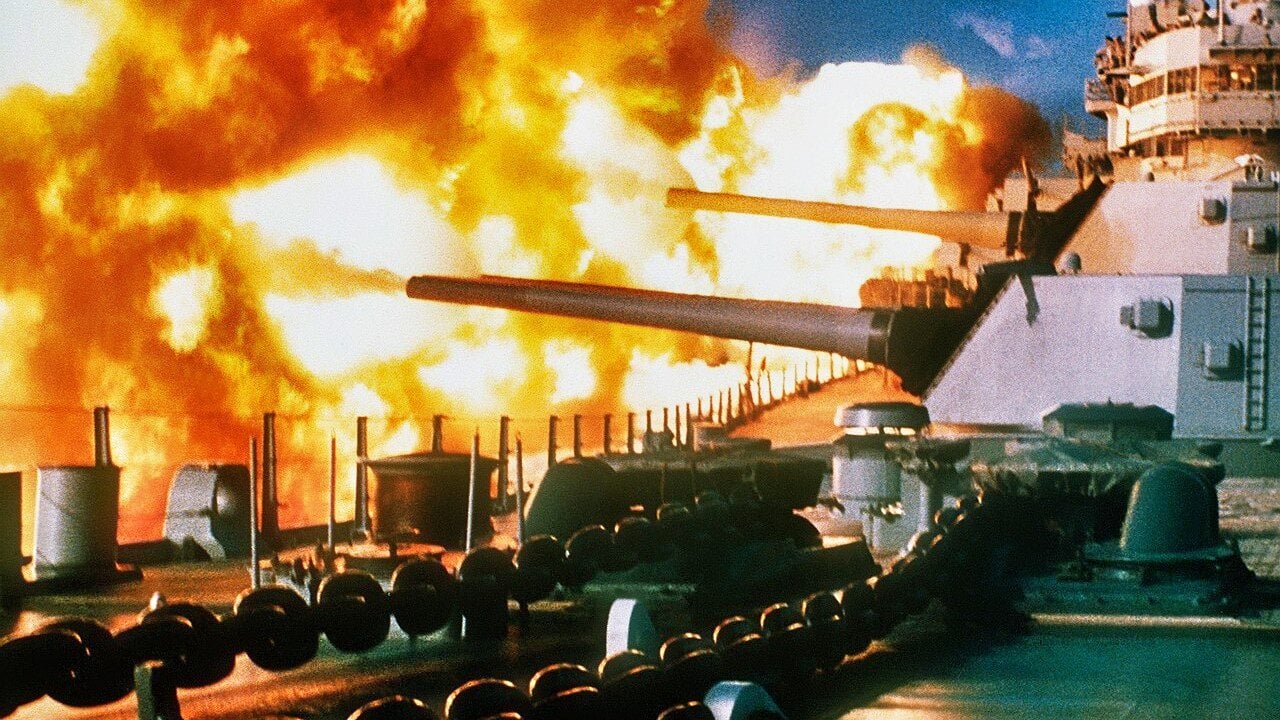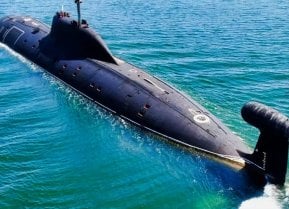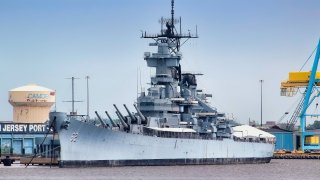Battleship USS New Jersey Is Making the Ultimate Comeback
Known as the "Big J" or "Black Dragon," USS New Jersey (BB-62) also has the distinction of being one of the most decorated battleships to have served in the U.S. Navy. She is now set for a long period of repair work.
The USS New Jersey is Ready to Move for First Time in Two Decades - One of the United States Navy's largest warships – not to mention the most decorated battleships – will be on the move this spring, for the first time in more than 20 years. The Iowa-class battleship USS New Jersey (BB-62) is noted for earning more battle stars than her sister vessels, while she was also the only U.S. battleship to provide gunfire support during the Vietnam War.
Known fondly as "Big J," the USS New Jersey has called the Camden Waterfront home since 2001, but this spring will depart the location.
No, the Big J isn't returning to action to confront Houthi rebels in the Red Sea and she won't be made ready for a potential conflict with China. Rather, the former BB-62 has been battling an even more insidious enemy for years – namely time and the elements. The impressive warship is set to be transported by tugboats to the North Atlantic Ship Repair facility at the Philadelphia Navy Yard.
The 45,000-ton historic vessel will be dry-docked in the very berth where it was built and subsequently launched on December 7, 1942.
"It's going back to Berth 3 because Berth 3 is big enough to hold it," Marshall Spevak, the interim chief executive officer of the Homeport Alliance, told The Philadelphia Inquirer .
The nonprofit corporation owns and operates the battleship as a museum and memorial.
USS New Jersey: Repairs Needed
According to the newspaper, the bottom of "Big J" will undergo routine maintenance, repairs, and repainting for the first time in 32 years. U.S. Navy maintenance guidelines for inactive ships call for dry-docking every 20 years. It is no small affair as the vessel is larger than the length of two football fields.
"We're way overdue and are moving forward now because it will be more expensive every year we wait,” said Spevak, who took a leave of absence as a partner at the Advocacy & Management Group, a Trenton lobbying firm, to take the interim CEO post. "I'm honored to take the helm and oversee this project. It's a once-in-a-lifetime opportunity to answer a higher calling of service."
The $10 million project, which is expected to take about two months, will include inspection of all 1,200 of the zinc nodes that form an electrical circuit protecting the submerged portion of the hull from corrosion. About half likely will need replacement. The goal is to have to the retired Iowa-class battleship back in Camden for Memorial Day and the peak tourist season.
"The ship needs to be inspected, repainted, updated, and brought back home to continue the mission," added Camden Mayor Vic Carstarphen, who described himself as "a huge supporter" of Big J. "That ship means so much to so many people, and it brings such value to the city, especially for our youth programs."
Iowa-Class Battleship: A True Fighting Ship
Built during the Second World War, the four vessels of Iowa-class were the largest battleships ever built for the United States Navy. Four of the planned six were completed, and they played a significant role in ensuring America's victory in the Pacific – and all four also saw service in the Korean War.
However, only BB-62 would go on to see action in Vietnam.
Known as the "Big J" or "Black Dragon," USS New Jersey (BB-62) also has the distinction of being one of the most decorated battleships to have served in the U.S. Navy, while she was also among the largest warships ever built. The second of the Iowa-class, like her sister vessels, she was designed as a "fast battleship" that could travel with a carrier force and take the fight to the Japanese during World War II.
Launched on December 7, 1942 – a year after the Japanese sneak attack on Pearl Harbor – the USS New Jersey was commissioned in May 1943 and began her career as the flagship of the 5th Fleet under Adm. Raymond A. Spruance.
In addition to her imposing size, the USS New Jersey earned a Guinness World Record for reaching a top speed of 35.2 knots (65.2 km/h) in 1968 and sustaining this for six hours.
Retired and Returned to Service
There was no place in the post-war world for massive battleships and in 1948 she was decommissioned. However, her fate wasn't sealed – and unlike so many warships that were broken up and sold as scrap, the Department of Defense sought to maintain the class of fast battleships.
USS New Jersey was returned to duty during the Korean War, and she served as the flagship for Vice Admiral Harold M. Martin. On May 20, 1951, she fired her first short bombardment in the conflict and took part in multiple subsequent seaborne sorties against Communist targets.
BB-62 remained active until 1957 when she was decommissioned a second time.
The Only Battleship Used in Vietnam
USS New Jersey was subsequently called up during the Vietnam War – becoming the only battleship to take part in the conflict in Southeast Asia. The actual reason was due to the high loss rate of U.S. aircraft – beginning with Operation Rolling Thunder in 1965 – and studies were conducted to determine how to reduce those losses, while still delivering the ordnance payloads that came with the escalation of the conflict.
In May 1967, then Secretary of Defense Robert McNamara authorized a study that aimed to determine how a battleship could fill the role. It was decided in August of that year to employ USS New Jersey to provide the fire support. BB-62 was selected for the role as she was in better material condition than her sisters, having received an extensive overhaul before decommissioning.
Upon her reactivation, USS New Jersey further underwent a period of modernization during which the 20 mm and 40 mm anti-aircraft guns on the battleship were removed, and she received improved electronic warfare systems and improvements to her radar.
From 1967-69, she was the only active battleship in the world.
In at least one occasion, the People's Army of Vietnam (PAVN) took a page from the Japanese playbook of World War II and claimed it had caused damage to the warship. The PAVN's 25th Battery, 21st Artillery Battalion using 130mm guns had fired at the warship – and it went so far as to suggest it set the battleship ablaze. That was of course wishful thinking.
In November 1968, USS New Jersey launched the most destructive shore bombardment of her Vietnam tour. For the following two days, the battleship concentrated her fire at Viet Cong storage areas near Qu ng Ngãi, during which time the warship successfully destroyed 182 structures and 54 bunkers, inflicted heavy damage to 93 structures, and demolished several tunnel complexes before departing for Point Betsy near Hue to support the 101st Airborne Division.
She continued to provide fire support in the early months of 1969, until April, when she departed for Japan. During her tour in Vietnam, the USS New Jersey fired more than 5,600 rounds from her 16-inch guns and nearly 15,000 from the five-inch guns.
Returned to Service A Final Time
In December 1969, her colors were hauled down and the warship was again deactivated, until the 1980s when President Ronald Reagan called for a 600-ship U.S. Navy. USS New Jersey again fired her big guns in combat during the Lebanon crisis of 1983-84 and was subsequently deployed to the western Pacific in 1986 and 1989-90, with the latter cruise extending to the Persian Gulf area.

Decommissioned again in February 1991, the USS New Jersey was towed from the Pacific to the Atlantic in 1999. The battleship earned nine battle stars for her World War II service, four for the Korean War, three for the Vietnam War, and three for action in Lebanon and the Persian Gulf region.

Since 2001 USS New Jersey has been preserved as a museum ship at Camden, New Jersey – a testament to the sailors who served on her in wartime and peacetime. The upcoming renovations will ensure the warship will remain a fitting memorial for generations to come.
Author Experience and Expertise:
Peter Suciu is a Michigan-based writer. He has contributed to more than four dozen magazines, newspapers, and websites with over 3,200 published pieces over a twenty-year career in journalism. He regularly writes about military hardware, firearms history, cybersecurity, politics, and international affairs. Peter is also a Contributing Writer for Forbes and Clearance Jobs. You can follow him on Twitter: @PeterSuciu.
All images are Shutterstock.


